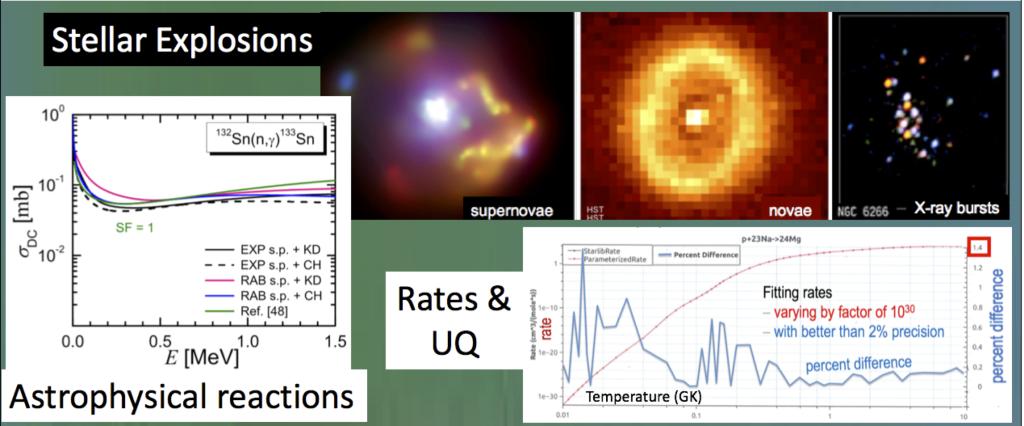
Nuclear Astrophysics Data
An important utilization of nuclear data is to understand the cosmos. Thermonuclear processes in the Universe determine the composition of our world and play a major role in its structure, evolution, and eventual fate. Nuclear science is important, for example, in the fusion of hydrogen and helium nuclei just a few minutes after the Big Bang, in the conversion of protons to neutrons during the collapse of the core of a massive star, in the capture of neutrons on heavy seeds above the surface of a newly formed neutron star, and in many other cosmic phenomena. The implications of nuclear processes are evident not only far out in space and back in time, but also in our everyday life: our bodies and our world are composed of the thermonuclear ashes of long dead stars, and the food chain on Earth and the stars we see in the night sky depend on the fusion of light nuclei deep in the cores of stars.
In many cases, the predictions of simulations of such diverse phenomena depend sensitively on nuclear physics input. For example, the flux of an X-ray burst has a qualitative and quantitative dependence on the half-lives of proton-rich nuclei above Iron; the heavy elements synthesized in supernovae depend on the masses, decay lifetimes, and neutron capture cross sections of neutron-rich unstable nuclei; and the sensitivity of sophisticated satellite observatories to nova outbursts depends on the rates of reactions on proton-rich exotic nuclei. As these astrophysical simulations become more and more sophisticated, they require more nuclear data. Furthermore, more precise nuclear data is needed to improve the quality of their predictions and, in cases such as supernova simulations utilizing millions of CPU hours on petascale supercomputers, to avoid costly miscalculations. Data on a wide variety of nuclear processes are needed for astrophysical simulations - including nuclear masses, capture reaction cross sections, weak decay rates, level densities, and nuclear matter compressibility. This information cuts across the traditional disciplines of nuclear structure and nuclear reactions. Thanks to the growing popularity of nuclear astrophysics studies, as well as advances such as sophisticated detector arrays (including the GODDESS system) and target systems (including the JENSA gas jet target), intense beams of radioactive nuclei, traps for high precision mass measurements, and global nuclear models running on supercomputers, new data are being generated at an ever-increasing rate.
In the ORNL Physics Division, a number of nuclear data activities are pursued to improve our understanding of stellar explosions and other astrophysical phenomena, including assessments of nuclear structure properties, examination of nuclear reaction cross sections, and data processing. For example, we have made an evaluation of the properties of the resonant levels in 19Ne above the 18F+p threshold. These level properties enabled us to calculate new thermonuclear reaction rates for 18F(p,alpha)15O and 18F(p,gamma)19Ne, and subsequently to improve our predictions of radionuclide production in novae.
Our work on the 17F(p,gamma)18Ne capture reaction exemplifies the close coupling of our experimental and data efforts at ORNL. We made the first direct measurement of this reaction at the HRIBF facility with a radioactive 17F beam to determine the gamma width of a crucial 18Ne resonance that dominates the 17F + p fusion rate in novae and X-ray bursts. This measurement, coupled with a data assessment, data processing to determine the best thermonuclear reaction rate, and a series of element synthesis calculations, changed the predictions of abundances of 18F and other isotopes that are synthesized in a nova outburst.
We also perform data processing work, such as fitting pointwise thermonuclear reaction rates (given as tables on a temperature grid), such as those in the NACRE collection, as analytical functions of temperature. This enables these rates to be incorporated in the most widely used collection of thermonuclear rates, the REACLIB library.
Finally, we also make calculations of thermonuclear rates and on the structure of exotic nuclei based on improved theoretical nuclear structure models. Recent examples have included 132Sn(n,gamma) capture reaction that occurs in supernova explosions, and 16O(n,gamma) that occurs in many intermediate mass stars.

